Theme Parks & Themed Entertainment
The post-Christmas origin of character dining at Walt Disney World

It's one of those must-do aspects of a Walt Disney World
vacation. Especially if you've got young kids. Character dining. That pricey breakfast,
lunch or dinner which is periodically interrupted as Disney characters come by
your table, pose for pictures and sign autographs.

Copyright Disney Enterprises, Inc. All rights reserved
Given that character dining is such a hugely popular – more
importantly, profitable — component of
the WDW vacation experience nowadays (Don't believe me? Then just check out those
lines of Guests outside of the Crystal Palace at the Magic Kingdom, Akershus
Royal Banquet Hall at Epcot, Hollywood & Vine at Disney's Hollywood Studios
and Tusker House Restaurant at Disney's
Animal Kingdom. Likewise that queue of customers outside of Chef Mickey's at
Disney's Contemporary Resort, the Cape May Cafe at Disney's Beach Club Resort
as well as 1900 Park Fare at Disney's Grand Floridian Resort & Spa), it
might surprise you to learn that the Disney World version of character dining
didn't get its start inside of a theme park and/or at one of the resorts. But –
rather – over at Lake Buena Vista in the shopping village.
Or – for that matter – that the first "character" which WDW
visitors had the chance to dine with wasn't Mickey Mouse or Winnie the Pooh or
any of the Disney Princesses. But – rather – Santa Claus.
It's kind of an interesting tale. But in order to properly
reveal the origins of character dining at Walt Disney World, I must first give
you a bit of backstory on that corner of the Resort which used to be known as the
Lake Buena Vista Shopping Village.
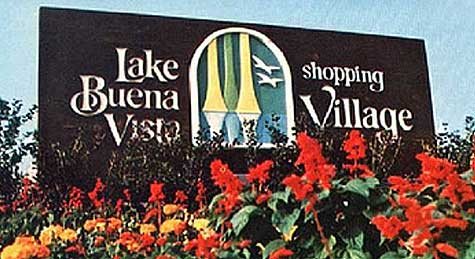
Copyright Disney Enterprises, Inc. All rights reserved
You see, back in the early 1970s, the folks in charge of
Walt Disney Productions wanted to make sure that the "Florida Project" truly was
an all-inclusive vacation resort. So it wasn't enough that Walt Disney World
had the Magic Kingdom, three themed hotels, two championship golf courses, a
campground, horseback riding, boating, water-skiing, bass fishing and the like.
The WDW Resort also had to have its own stand-alone retail & dining
district.
Mind you, construction of the Lake Buena Vista Shopping
Village didn't go forward just because the Company was looking for new &
different ways to get tourists to open their wallets. No, back in the early
1970s, Mouse House managers still had hopes that they'd someday be able to
deliver on Walt's last & greatest dream (i.e. pull a genuine city-of-the-future
up out of the swamps of Central Florida). And by constructing some sort of
commercial center out by what was then-known as Motor Inn Plaza … Well, that
seemed like kind of a smart intermediate step towards the Company's ultimate
goal of building Epcot-the-city.
Still, Disney being Disney … The Lake Buena Vista Shopping
Village couldn't just resemble the mall that folks had back at home. It had to
have a distinctly different take on the shopping experience. Much is the same
way that a Disney theme park was distinctly different from your average
regional amusement park.
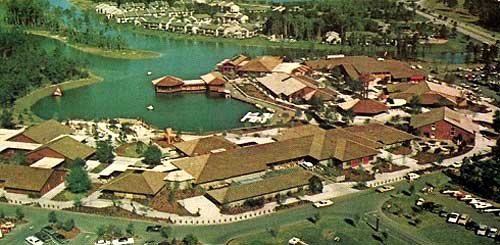
Copyright Disney Enterprises, Inc. All rights reserved
Which is why – rather than go with the standard indoor mall
floor plan — the Imagineers opted instead to build WDW's retail & dining
district outdoors along the shores of Lake Buena Vista. More to the point, that
this complex of 32 boutique and handicraft shops would be built out of
weathered wood & brick. And as shoppers wandered among these cedar-shingled
structures, they could then peer in through windows and watch as old-world
craftsmen cut crystal, shaped clay pots and engraved gold.
You get the idea yet? What Disney was trying to with the
Lake Buena Vista Shopping Village was build the anti-mall. Create a unique
dining & retail experience that would not only appeal to WDW visitors but
also draw in leisure shoppers from all over the Central Florida region.
That was the plan, anyway. But when the Lake Buena Vista
Shopping Village opened on March 22, 1975, it quickly became apparent that
something was amiss. For while the Guests who were actually staying at the
Dutch Resort Hotel, Howard Johnson's, The Hotel Royal Plaza and Travelodge
Tower would schlep across the street from Hotel Plaza and then for check this
place out … That wasn't exactly the case for people staying at the
Contemporary, the Polynesian Village, the Golf Resort and Fort Wilderness
Campground. Or – for that matter – most of the day guests who were visiting the
Magic Kingdom.
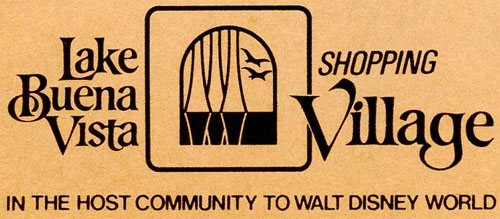
Copyright Disney Enterprises, Inc. All rights reserved
In fact, the Lake Buena Vista Shopping Village was capturing
such a small share of WDW Resort guests and day visitors to the theme park that
– in late 1975 / early 1976 – the Company commissioned a survey about this
shopping & dining district. And what they discovered back then really
startled them.
The biggest problem that the Lake Buena Vista Shopping
Village faced was that most tourists didn't link the Buena Vista name with Walt
Disney World. So when they heard "Lake Buena Vista Shopping Village," these
people thought that it was just another off-property attraction like SeaWorld
or Church Street Station. But worse than that, those WDW Resort guests who did
make a special trip over the Shopping Village to experience these artfully
designed collection of boutiques & restaurants said that they wouldn't be returning
anytime soon because – to be blunt – it just wasn't Disney enough.
So to quickly address these issues, the suits in Burbank
first decided to change the name of WDW's dining & retail district. Which –
in late 1976 / early 1977 – went from being the Lake Buena Vista Shopping Village
to the Walt Disney World Village. They also made sure that every new ticket
book sold for the Magic Kingdom then featured an ad that urged theme park goers
to " … Visit the other side of the World … You haven't seen the whole World
until you've visited Walt Disney World Village at Lake Buena Vista. Open daily
10 to 10."
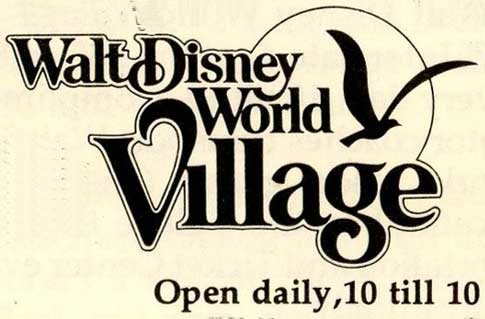
Copyright Disney Enterprises, Inc. All rights reserved
And to counter Guest complaints that " … this shopping
village just isn't Disney enough," the Imagineers then decided to build an
iconic piece of Disneyland Park and WDW's Magic Kingdom. Which was a recreation of a three-decked Mississippi River
stern-wheeler that would then be parked right along the shore of Buena Vista
Lagoon. Which – the wizards of WED hoped – would become the new focal point of
the shopping village.
And Disney spared no expense when it came to the
construction this 150-ton vessel (which – truth be told – wasn't a steamboat at
all. But – rather – a restaurant complex designed to look like a boat which
then sat on this submerged concrete foundation). With two 84-foot smoke stacks,
its 22-by-36-foot churning paddle wheel as well as its gingerbread railings, this
steamboat – at 220 feet long by 62 feet wide – was twice the size of the
paddle-wheelers which cruised around the Rivers of America at the Magic Kingdom.
And as for those " … this shopping village isn't Disney
enough" complaints … Well, that's why the Imagineers opted to name this faux
steamboat the Empress Lilly after Walt's wife, Lillian. In fact, on May 1,
1977, Lillian herself took part in the gala private christening ceremony for
this new WDW restaurant complex. And as she toured this building with Donn Tatum,
Mrs. Disney Truyens supposedly commented on the antique 24-foot-table inlaid
parquet table that she found in the Texas Deck Lounge. Which had reportedly
been chosen by Walt himself to serve as the dining table for the Disney family
suite that was supposed to be built over "Pirates of the Caribbean" in
Disneyland's New Orleans Square area.
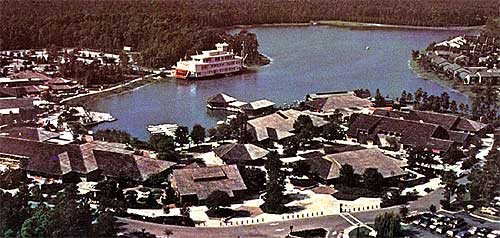
Copyright Disney Enterprises, Inc. All rights reserved
And while the name change as well as the addition of the
Empress Lilly did compel more WDW Guests to go visit the Walt Disney World
Village, this retail & dining district still struggled to catch on with
Central Floridians. So to draw even more leisure shoppers from the region,
Disney was then forced to start staging all sorts of special weekend-long
events down along the shore of Lake Buena. The Boat Show, The Car Show, The
Festival of the Masters. Anything that Mouse House managers could think of as a
possible way to lure in additional local customers in.
And given that – at least back in the mid-1970s, anyway –
the weeks leading up to the holidays were an especially slow time for the Walt
Disney World Resort … Well, that's why the folks who ran WDW's shopping village
began staging the "The Glory and Pageantry of Christmas" there. Which was this
Renaissance-style, live Nativity scene that was staged right under the
Captain's Tower right at the very heart of this shopping & dining district.
Given that we now live in an age when people will actually go
to court to prevent a crèche from being placed on public property, it must seem
kind of bizarre to hear that – right up until the mid-1990s – that this
traditional retelling of the Christmas story was staged during the month of
December right on WDW property. And the "The Glory and Pageantry of Christmas"
was a pretty elaborate affair, featuring 39 cast members and live animals. Not
to mention the Dickens Carolers from the Magic Kingdom, which – between scenes
– performed such decidedly non-secular tunes as "O Little Town of Bethlehem,"
"Away in a Manger," "Hark, the Herald Angels Sing" and "We Three Kings."

The finale of "The Glory and Pageantry of Christmas" living Nativity at the Walt Disney
World Village. Copyright Disney Enterprises, Inc. All rights reserved
"The Glory and Pageantry of Christmas" became so popular
with Central Floridians that there were nights where – in order to deal with
the crowds – the Walt Disney World Village was forced to present three
performances of this living Nativity nightly, once at 6, 7:30 & 9 p.m.
Which was great when it came to bringing nighttime shoppers
into WDW Village during the month of December. But as for the early morning
hours, Disney World's shopping village genuinely struggled when it came to
bringing in customers. Or at least it did until one enterprising Mouse House
manager decided to borrow a bit of holiday magic from the local mall.
As Disneyland president George Kalogridis recounted at his
"A Word from the President" presentation at D23's Destination D: Disneyland '55
event in September of 2010, one member of the WDW Shopping Village's management
team noticed that several Orlando area malls were doing extremely well with
their "Have Breakfast with Santa" promotions. So why couldn't Disney stage a similar
sort of event to convince shoppers to come out to Lake Buena Vista during the
early morning hours?

As this image capture from "Holiday Time at Disneyland" (i.e. the "Wonderful World of
Color" episode that originally aired on December 23, 1962) proves, Walt and Santa
go way back. Copyright Disney Enterprises, Inc. All rights reserved
So – just as a test in December of 1977 – the Walt Disney
World Village put together a "Have Breakfast with Santa" promotion. Where kids
& their parents would come on board the Empress Lilly (which was completely
open and available at that time of day. Given that – at this point in its
operating history, anyway – this riverboat restaurant wasn't serving breakfast.
It only served lunch & dinner) and enjoy some scrambled eggs, bacon and
pancakes while Santa slowly worked his way around the Promenade Deck and
visited with every child at every table.
To hear Kalogridis tell this story, the "Have Breakfast with
Santa" promotion was a huge seasonal success. Resulting in huge foot traffic
through the stores. More importantly, an overall increase in sales at the Walt
Disney World Village at a time of day when this retail & dining area was
usually dead.
But then December gave way to January. And as the morning
foot traffic and per-store sales slumped to their usual pre-holiday levels,
Walt Disney World Shopping Village managers wondered if there was a way that
they could perhaps replicate the "Have Breakfast with Santa" phenomenon by –
say – giving WDW Guests the chance to dine with some of their favorite Disney
characters.

Copyright Disney Enterprises, Inc. All rights reserved
Which is why – in February of 1978 – the WDW Shopping
Village began offering a "Have Breakfast with Snow White and Friends" event aboard
the Empress Lilly. Which immediately became hugely popular with Resort
visitors. So much so that – at the height of its popularity – the
eventually-renamed "Breakfast a la Disney" was selling out three seatings
daily.
Which is why – in order to deal with demand – Walt Disney
World then began offering character dining at other venues around the Resort.
Among them the Minnie's Menehune Breakfast at the Papeete Bay Veranda at the
Polynesian Village and Melvin the Moose's Country Breakfast Jamboree at Fort
Wilderness's Pioneer Hall. And with the success of these spin-off character
breakfast events, it was only a matter of time before the Parks got involved.
And now that character dining is a standard feature at every
WDW theme park and at virtually every Resort on property … Well, to me, anyway,
it just seems a little less special.
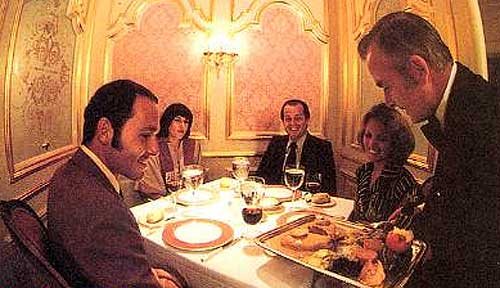
French-style service in the Louis-the-XV -themed Empress Room.
Copyright Disney Enterprises, Inc. All rights reserved
But – then again – the entire Walt Disney World Resort has
seemed like a less special place since the Empress Lilly was closed on April
22, 1995 and then gutted to make way for Fulton's Crab House … If you ever got
the chance to dine in the Empress Room with its glimmering chandeliers, as the attentive
staff there served gourmet fare on special made-to-order china … Well, that was
an evening that you'd never ever forget.
Likewise the great Dixieland music that you used to be able to hear played nightly
inside of the Baton Rouge Lounge. Or those Monday Night Huddle events. Where Tampa
Bay Buccaneers players would — every Monday evening from early September through
late December – come on board the Empress Lilly riverboat restaurant and then review
the previous day's football game, showing play-by-play films as well as responding
to questions from the crowd.
Yeah, the Lake Buena Vista Shopping Village / Walt Disney
World Village may have not been hugely successful as Walt Disney Productions
officials had hoped that it would be in the mid-to-late 1970s (And one wonders
what would have happened if Card Walker had ever followed through with his
post-Epcot-opening plan. Which was to add a third loop to the Resort's monorail
system, which would have then allowed visitors to that futuristic theme park to
travel over to the Walt Disney World Village & Hotel Plaza area and then
disembark for a bit of shopping & dining).
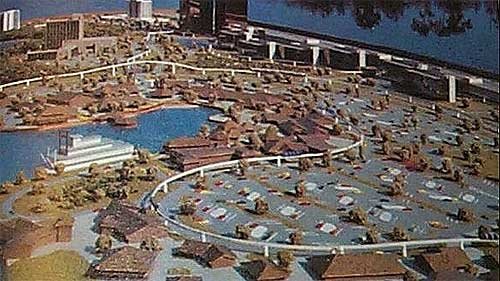
A model of the future expansion of WDW's Hotel Plaza area. Please note the proposed
monorail loop that would have not only serviced these hotels but also the Walt Disney
World Village. Copyright Disney Enterprises, Inc. All rights reserved
Anyway … So if you or your family has ever enjoyed a bit of
character dining while vacationing at the Walt Disney World Resort, you have
the managers of the Lake Buena Vista Shopping Village / Walt Disney World
Village to thank. Who were only looking for additional ways to make the cash registers
ring at WDW's dining & retail district after the holidays when they then
came up with the idea of charging Guests to eat breakfast on board the Empress
Lilly with Snow White & friends.
Which seems like a suitable post-holiday story, don't you
think?
Anyway … How many of you out there also have fond memories
of the Empress Lilly and/or have stories to share about memorable character
encounters that you & family members may have had at a "Breakfast A La Disney"
?
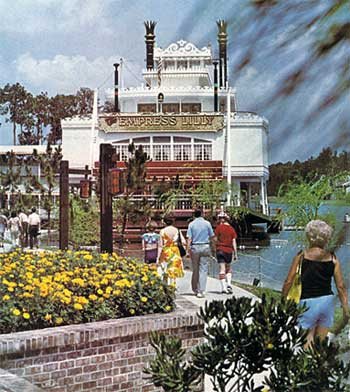
Copyright Disney Enterprises, Inc. All rights reserved
Your thoughts?
Tis the season, folks. So as 2011 winds down, if you've enjoyed what you've read on JHM over the past year, please feel free to throw a little something-something in
this site's new tip jar.
History
The Evolution and History of Mickey’s ToonTown

Disneyland in Anaheim, California, holds a special place in the hearts of Disney fans worldwide, I mean heck, it’s where the magic began after all. Over the years it’s become a place that people visit in search of memorable experiences. One fan favorite area of the park is Mickey’s Toontown, a unique land that lets guests step right into the colorful, “Toony” world of Disney animation. With the recent reimagining of the land and the introduction of Micky and Minnies Runaway Railway, have you ever wondered how this land came to be?
There is a fascinating backstory of how Mickey’s Toontown came into existence. It’s a tale of strategic vision, the influence of Disney executives, and a commitment to meeting the needs of Disney’s valued guests.
The Beginning: Mickey’s Birthdayland
The story of Mickey’s Toontown starts with Mickey’s Birthdayland at Walt Disney World’s Magic Kingdom. Opened in 1988 to celebrate Mickey Mouse’s 60th birthday, this temporary attraction was met with such overwhelming popularity that it inspired Disney executives to think bigger. The idea was to create a permanent, immersive land where guests could step into the animated world of Mickey Mouse and his friends.
In the early ’90s, Disneyland was in need of a refresh. Michael Eisner, the visionary leader of The Walt Disney Company at the time, had an audacious idea: create a brand-new land in Disneyland that would celebrate Disney characters in a whole new way. This was the birth of Mickey’s Toontown.
Initially, Disney’s creative minds toyed with various concepts, including the idea of crafting a 100-Acre Woods or a land inspired by the Muppets. However, the turning point came when they considered the success of “Who Framed Roger Rabbit.” This film’s popularity and the desire to capitalize on contemporary trends set the stage for Toontown’s creation.
From Concept to Reality: The Birth of Toontown
In 1993, Mickey’s Toontown opened its gates at Disneyland, marking the first time in Disney Park history where guests could experience a fully realized, three-dimensional world of animation. This new land was not just a collection of attractions but a living, breathing community where Disney characters “lived,” worked, and played.
Building Challenges: Innovative Solutions
The design of Mickey’s Toontown broke new ground in theme park aesthetics. Imagineers were tasked with bringing the two-dimensional world of cartoons into a three-dimensional space. This led to the creation of over 2000 custom-built props and structures that embodied the ‘squash and stretch’ principle of animation, giving Toontown its distinctiveness.
And then there was also the challenge of hiding the Team Disney Anaheim building, which bore a striking resemblance to a giant hotdog. The Imagineers had to think creatively, using balloon tests and imaginative landscaping to seamlessly integrate Toontown into the larger park.

Key Attractions: Bringing Animation to Life
Mickey’s Toontown featured several groundbreaking attractions. “Roger Rabbit’s Car Toon Spin,” inspired by the movie “Who Framed Roger Rabbit,” became a staple of Toontown, offering an innovative ride experience. Gadget’s Go-Coaster, though initially conceived as a Rescue Rangers-themed ride, became a hit with younger visitors, proving that innovative design could create memorable experiences for all ages.
Another crown jewel of Toontown is Mickey’s House, a walkthrough attraction that allowed guests to explore the home of Mickey Mouse himself. This attraction was more than just a house; it was a carefully crafted piece of Disney lore. The house was designed in the American Craftsman style, reflecting the era when Mickey would have theoretically purchased his first home in Hollywood. The attention to detail was meticulous, with over 2000 hand-crafted, custom-built props, ensuring that every corner of the house was brimming with character and charm. Interestingly, the design of Mickey’s House was inspired by a real home in Wichita Falls, making it a unique blend of real-world inspiration and Disney magic.
Mickey’s House also showcased Disney’s commitment to creating interactive and engaging experiences. Guests could make themselves at home, sitting in Mickey’s chair, listening to the radio, and exploring the many mementos and references to Mickey’s animated adventures throughout the years. This approach to attraction design – where storytelling and interactivity merged seamlessly – was a defining characteristic of ToonTown’s success.

Executive Decisions: Shaping ToonTown’s Unique Attractions
The development of Mickey’s Toontown wasn’t just about creative imagination; it was significantly influenced by strategic decisions from Disney executives. One notable input came from Jeffrey Katzenberg, who suggested incorporating a Rescue Rangers-themed ride. This idea was a reflection of the broader Disney strategy to integrate popular contemporary characters and themes into the park, ensuring that the attractions remained relevant and engaging for visitors.
In addition to Katzenberg’s influence, Frank Wells, the then-President of The Walt Disney Company, played a key role in the strategic launch of Toontown’s attractions. His decision to delay the opening of “Roger Rabbit’s Car Toon Spin” until a year after Toontown’s debut was a calculated move. It was designed to maintain public interest in the park by offering new experiences over time, thereby giving guests more reasons to return to Disneyland.
These executive decisions highlight the careful planning and foresight that went into making Toontown a dynamic and continuously appealing part of Disneyland. By integrating current trends and strategically planning the rollout of attractions, Disney executives ensured that Toontown would not only capture the hearts of visitors upon its opening but would continue to draw them back for new experiences in the years to follow.
Global Influence: Toontown’s Worldwide Appeal
The concept of Mickey’s Toontown resonated so strongly that it was replicated at Tokyo Disneyland and influenced elements in Disneyland Paris and Hong Kong Disneyland. Each park’s version of Toontown maintained the core essence of the original while adapting to its cultural and logistical environment.
Evolution and Reimagining: Toontown Today
As we approach the present day, Mickey’s Toontown has recently undergone a significant reimagining to welcome “Mickey & Minnie’s Runaway Railway” in 2023. This refurbishment aimed to enhance the land’s interactivity and appeal to a new generation of Disney fans, all while retaining the charm that has made ToonTown a beloved destination for nearly three decades.

Dive Deeper into ToonTown’s Story
Want to know more about Mickey’s Toontown and hear some fascinating behind-the-scenes stories, then check out the latest episode of Disney Unpacked on Patreon @JimHillMedia. In this episode, the main Imagineer who worked on the Toontown project shares lots of interesting stories and details that you can’t find anywhere else. It’s full of great information and fun facts, so be sure to give it a listen!
History
Unpacking the History of the Pixar Place Hotel

Pixar Place Hotel, the newly unveiled 15-story tower at the Disneyland Resort, has been making waves in the Disney community. With its unique Pixar-themed design, it promises to be a favorite among visitors.
However, before we delve into this exciting addition to the Disneyland Resort, let’s take a look at the fascinating history of this remarkable hotel.
The Emergence of the Disneyland Hotel
To truly appreciate the story of the Pixar Place Hotel, we must turn back the clock to the early days of Disneyland. While Walt Disney had the visionary ideas and funding to create the iconic theme park, he faced a challenge when it came to providing accommodations for the park’s visitors. This is where his friend Jack Wrather enters the picture.
Jack Wrather, a fellow pioneer in the television industry, stepped in to assist Walt Disney in realizing his dream. Thanks to the success of the “Lassie” TV show produced by Wrather’s company, he had the financial means to build a hotel right across from Disneyland.
The result was the Disneyland Hotel, which opened its doors in October 1955. Interestingly, the early incarnation of this hotel had more of a motel feel than a hotel, with two-story buildings reminiscent of the roadside motels popular during the 1950s. The initial Disneyland Hotel consisted of modest structures that catered to visitors looking for affordable lodging close to the park. While the rooms were basic, it marked the beginning of something extraordinary.
The Evolution: From Emerald of Anaheim to Paradise Pier
As Disneyland’s popularity continued to soar, so did the demand for expansion and improved accommodations. In 1962, the addition of an 11-story tower transformed the Disneyland Hotel, marking a significant transition from a motel to a full-fledged hotel.
The addition of the 11-story tower elevated the Disneyland Hotel into a more prominent presence on the Anaheim skyline. At the time, it was the tallest structure in all of Orange County. The hotel’s prime location across from Disneyland made it an ideal choice for visitors. With the introduction of the monorail linking the park and the hotel, accessibility became even more convenient. Unique features like the Japanese-themed reflecting pools added to the hotel’s charm, reflecting a cultural influence that extended beyond Disney’s borders.
Japanese Tourism and Its Impact
During the 1960s and 1970s, Disneyland was attracting visitors from all corners of the world, including Japan. A significant number of Japanese tourists flocked to Anaheim to experience Walt Disney’s creation. To cater to this growing market, it wasn’t just the Disneyland Hotel that aimed to capture the attention of Japanese tourists. The Japanese Village in Buena Park, inspired by a similar attraction in Nara, Japan, was another significant spot.
These attractions sought to provide a taste of Japanese culture and hospitality, showcasing elements like tea ceremonies and beautiful ponds with rare carp and black swans. However, the Japanese Village closed its doors in 1975, likely due to the highly competitive nature of the Southern California tourist market.
The Emergence of the Emerald of Anaheim
With the surge in Japanese tourism, an opportunity arose—the construction of the Emerald of Anaheim, later known as the Disneyland Pacific Hotel. In May 1984, this 15-story hotel opened its doors.
What made the Emerald unique was its ownership. It was built not by The Walt Disney Company or the Oriental Land Company (which operated Tokyo Disneyland) but by the Tokyu Group. This group of Japanese businessmen already had a pair of hotels in Hawaii and saw potential in Anaheim’s proximity to Disneyland. Thus, they decided to embark on this new venture, specifically designed to cater to Japanese tourists looking to experience Southern California.
Financial Challenges and a Changing Landscape
The late 1980s brought about two significant financial crises in Japan—the crash of the NIKKEI stock market and the collapse of the Japanese real estate market. These crises had far-reaching effects, causing Japanese tourists to postpone or cancel their trips to the United States. As a result, reservations at the Emerald of Anaheim dwindled.
To adapt to these challenging times, the Tokyu Group merged the Emerald brand with its Pacific hotel chain, attempting to weather the storm. However, the financial turmoil took its toll on the Emerald, and changes were imminent.
The Transition to the Disneyland Pacific Hotel
In 1995, The Walt Disney Company took a significant step by purchasing the hotel formerly known as the Emerald of Anaheim for $35 million. This acquisition marked a change in the hotel’s fortunes. With Disney now in control, the hotel underwent a name change, becoming the Disneyland Pacific Hotel.
Transformation to Paradise Pier
The next phase of transformation occurred when Disney decided to rebrand the hotel as Paradise Pier Hotel. This decision aligned with Disney’s broader vision for the Disneyland Resort.
While the structural changes were limited, the hotel underwent a significant cosmetic makeover. Its exterior was painted to complement the color scheme of Paradise Pier, and wave-shaped crenellations adorned the rooftop, creating an illusion of seaside charm. This transformation was Disney’s attempt to seamlessly integrate the hotel into the Paradise Pier theme of Disney’s California Adventure Park.
Looking Beyond Paradise Pier: The Shift to Pixar Place
In 2018, Disneyland Resort rebranded Paradise Pier as Pixar Pier, a thematic area dedicated to celebrating the beloved characters and stories from Pixar Animation Studios. As a part of this transition, it became evident that the hotel formally known as the Disneyland Pacific Hotel could no longer maintain its Paradise Pier theme.
With Pixar Pier in full swing and two successful Pixar-themed hotels (Toy Story Hotels in Shanghai Disneyland and Tokyo Disneyland), Disney decided to embark on a new venture—a hotel that would celebrate the vast world of Pixar. The result is Pixar Place Hotel, a 15-story tower that embraces the characters and stories from multiple Pixar movies and shorts. This fully Pixar-themed hotel is a first of its kind in the United States.
The Future of Pixar Place and Disneyland Resort
As we look ahead to the future, the Disneyland Resort continues to evolve. The recent news of a proposed $1.9 billion expansion as part of the Disneyland Forward project indicates that the area surrounding Pixar Place is expected to see further changes. Disneyland’s rich history and innovative spirit continue to shape its destiny.
In conclusion, the history of the Pixar Place Hotel is a testament to the ever-changing landscape of Disneyland Resort. From its humble beginnings as the Disneyland Hotel to its transformation into the fully Pixar-themed Pixar Place Hotel, this establishment has undergone several iterations. As Disneyland Resort continues to grow and adapt, we can only imagine what exciting developments lie ahead for this iconic destination.
If you want to hear more stories about the History of the Pixar Place hotel, check our special edition of Disney Unpacked over on YouTube.
Stay tuned for more updates and developments as we continue to explore the fascinating world of Disney, one story at a time.
History
From Birthday Wishes to Toontown Dreams: How Toontown Came to Be

In the latest release of Episode 4 of Disney Unpacked, Len and I return, joined as always by Disney Imagineering legend, Jim Shull. This two-part episode covers all things Mickey’s Birthday Land and how it ultimately led to the inspiration behind Disneyland’s fan-favorite land, “Toontown”. But let’s not get ahead of ourselves here. It all starts in the early days at Disneyland.
Early Challenges in Meeting Mickey
Picture this: it’s the late 1970s and early 1980s, and you’re at Disneyland. You want to meet the one and only Mickey Mouse, but there’s no clear way to make it happen. You rely on Character Guides, those daily printed sheets that point you in Mickey’s general direction. But let’s be honest, it was like finding a needle in a haystack. Sometimes, you got lucky; other times, not so much.

Mickey’s Birthdayland: A Birthday Wish that Came True
Fast forward to the late 1980s. Disney World faced a big challenge. The Disney-MGM Studios Theme Park was under construction, with the company’s marketing machine in full swing, hyping up the opening of Walt Disney World’s third theme park, MGM Studios, in the Spring of 1989. This extensive marketing meant that many people were opting to postpone their family’s next trip to Walt Disney World until the following year. Walt Disney World needed something compelling to motivate guests to visit Florida in 1988, the year before Disney MGM Studios opened.
Enter stage left, Mickey’s Birthdayland. For the first time ever, an entire land was dedicated to a single character – and not just any character, but the mouse who started it all. Meeting Mickey was no longer a game of chance; it was practically guaranteed.

The Birth of Birthdayland: Creative Brilliance Meets Practicality
In this episode, we dissect the birth of Mickey’s Birthdayland, an initiative that went beyond celebrating a birthday. It was a calculated move, driven by guest feedback and a need to address issues dating back to 1971. Imagineers faced the monumental task of designing an experience that honored Mickey while efficiently managing the crowds. This required the perfect blend of creative flair and logistical prowess – a hallmark of Disney’s approach to theme park design.
Evolution: From Birthdayland to Toontown
The success of Mickey’s Birthdayland was a real game-changer, setting the stage for the birth of Toontown – an entire land that elevated character-centric areas to monumental new heights. Toontown wasn’t merely a spot to meet characters; it was an immersive experience that brought Disney animation to life. In the episode, we explore its innovative designs, playful architecture, and how every nook and cranny tells a story.

Impact on Disney Parks and Guests
Mickey’s Birthdayland and Toontown didn’t just reshape the physical landscape of Disney parks; they transformed the very essence of the guest experience. These lands introduced groundbreaking ways for visitors to connect with their beloved characters, making their Disney vacations even more unforgettable.
Beyond Attractions: A Cultural Influence
But the influence of these lands goes beyond mere attractions. Our episode delves into how Mickey’s Birthdayland and Toontown left an indelible mark on Disney’s culture, reflecting the company’s relentless dedication to innovation and guest satisfaction. It’s a journey into how a single idea can grow into a cherished cornerstone of the Disney Park experience.

Unwrapping the Full Story of Mickey’s Birthdayland
Our two-part episode of Disney Unpacked is available for your viewing pleasure on our Patreon page. And for those seeking a quicker Disney fix, we’ve got a condensed version waiting for you on our YouTube channel. Thank you for being a part of our Disney Unpacked community. Stay tuned for more episodes as we continue to “Unpack” the fascinating world of Disney, one story at a time.
-
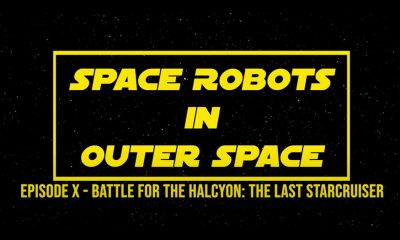
 News & Press Releases12 months ago
News & Press Releases12 months agoStar Wars Spoof: Space Robots in Outer Space Ep X: Battle for the Halcyon: The Last Starcruiser
-

 History11 months ago
History11 months ago31 Long-Gone Rides, Shows & Attractions at Disney-MGM (Hollywood Studios)
-

 News & Press Releases8 months ago
News & Press Releases8 months agoDisney Will Bring D23: The Ultimate Disney Fan Event to Anaheim, California in August 2024
-

 Theme Parks & Themed Entertainment11 months ago
Theme Parks & Themed Entertainment11 months agoFrom Aladdin to Indy – How Did We Get an Indiana Jones Stage Show at Disneyland?
-

 History3 months ago
History3 months agoFrom Birthday Wishes to Toontown Dreams: How Toontown Came to Be
-

 Theme Parks & Themed Entertainment12 months ago
Theme Parks & Themed Entertainment12 months agoHow Did We Get “Aladdin’s Oasis” at Disneyland?
-

 Theme Parks & Themed Entertainment10 months ago
Theme Parks & Themed Entertainment10 months agoWhen WDW Had a Racetrack – The Creation of the Walt Disney World Speedway
-

 Film & Movies10 months ago
Film & Movies10 months ago“Indiana Jones and the Search for Indiana Jones”









